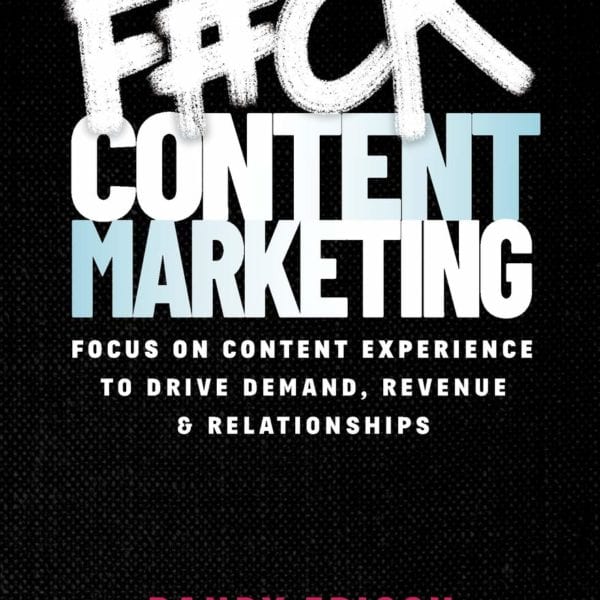
B2B CMOs: Your Content Needs a Framework
Randy Frisch, President & CMO of Uberflip, has ruffled a few feathers in evangelizing his marketing mindset. Why? Well, right off the bat, he’s published a book called F*ck Content Marketing, which is sure to rub a few people the wrong way. But his mindset isn’t as negative as it may sound—in fact, he ends up highlighting the value of content marketing, but also pointing to a serious need to develop frameworks around it, something not enough marketers are doing. In a follow-up exchange after our recent interview, Randy answered a few more questions, and dove a bit further into how Uberflip has worked out a framework for their strategies.
What metrics help you identify if content is working in your framework?
The chart below highlights the metrics we evaluate at each stage of the buyer journey to ensure our content is impacting pipeline and revenue:

What's an example of a recent campaign where you used your content framework?
We use the Content Experience Framework to build out every campaign we launch, so I’ll give you an example from a recent campaign we ran to promote our latest trends report.
A lot of the assets we wanted to use in our campaign already existed in our content library, but we also filmed some quick tip videos to support the themes mentioned in the report. Then we pulled all of the assets we wanted to use into a single stream of content to build out an experience. Since the research in the report was coming from our Senior Content Marketing Manager, she personalized the content stream’s messaging, creative, and calls-to-action to indicate it was coming from her, as well as matched it to the branding of the report. We then distributed it through email, social, and paid ads and saw awesome results.
The asset was a top-performer for us for sure, but what's more interesting is what people did after they converted on it. Rather than leaving our site, we kept them contained in one content experience that encouraged them to keep consuming, with the average person viewing 6.74 pieces of content.
How do you people get from one piece of content to the next?
With all content—whether it’s part of a campaign or simply on your blog—there should always be a next step. At Uberflip, there are three main ways we make this happen: CTAs that appear beside pieces of content, “next article” buttons at the bottom of our content, and AI-powered content recommendations based on a visitor’s browsing patterns. Whether you’re using just one CTA placement or all three, the key is to ensure your calls-to-action are contextual and relevant to the asset they’re engaging with, their persona, and their stage in the buyer journey.
How can you determine which channels are the best for your content?
We lean on data to determine which channels perform the best for us. We don’t just look at traffic or leads generated, we also evaluate the quality of leads coming in and where they are informing pipeline through each channel in order to make more informed decisions on where to double-down on our efforts and where we can scale back.
What would be the flow of an ideal content experience look like?
When someone lands on your page, you’ll want to capture their attention. To do this, you need to start by thinking about your content’s environment—which is essentially the wrapper. Your content should be presented in an environment that looks professional and is consistent with what people would expect from your brand. After someone’s pulled in by the appearance of your experience, you need to hook them with a solid structure. This includes everything related to organization, navigation, and curation that will affect your visitors' ability to discover useful, relevant content. And lastly, your experience should compel action, so you’ll want to include personalized and relevant recommendations and calls-to-action that are tailored to your buyer’s interests. Each of these elements add up to how your audience—whether they’re customers or prospects—feels about your company. And all of these experiences build the trust needed to establish a meaningful relationship between them and you.
How have you gotten internal buy-in for the 'f#ck content marketing' mindset?
It started with realizing that we had a problem—we were so focused on creating more and more content. Even I as a CMO was partially to blame. At one point I remember saying that we are not creating enough content on a weekly, monthly, or regular cadence and I assumed that we weren’t getting people to come to our website and discover.
I then realized that people weren’t always coming to our website to discover. They were coming when they were ready to buy or when they were ready to engage with our product and learn more. People weren’t engaging because the content wasn’t relevant.
You have to decide what your goal is with your content strategy—do you want to be a company like HubSpot who really is a go-to for knowledge, or do you want to focus your content strategy on moving people through the buyer journey. We didn’t really want to saddle ourselves to being a thought leader, we wanted to move people through the buyer journey and keep them engaged. When the focus is on the buyer journey or engagement, it’s less about having enough content, and more about serving relevant content to the right people at the right time. And that may mean that what’s new to one buyer may be the right content from months ago that you’re now surfacing to engage them.
Walking the team through that change in mindset really helped to get internal buy-in from the team. The name (“F#ck Content Marketing”’) was a little harder to get buy-in for (you’ll need to read my book for the story on that).